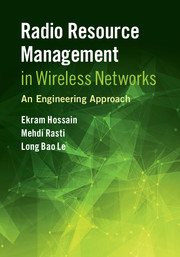Book contents
- Frontmatter
- Contents
- Preface
- Part I Basics of Wireless Networks
- Part II Techniques for Modeling and Analysis of Radio Resource Allocation Methods in Wireless Networks
- Part III Physical Layer Resource Allocation in Wireless Networks
- Part IV Link Layer Resource Allocation in Wireless Networks
- 10 Sub-Carrier/Sub-Channel Allocation in OFDMA Networks
- 11 Resource Allocation in Relay-Based Networks
- 12 Channel Allocation for Infrastructure-Based 802.11 WLANs
- Part V Cross-Layer Modeling for Resource Allocation in Wireless Networks
- Index
- References
11 - Resource Allocation in Relay-Based Networks
from Part IV - Link Layer Resource Allocation in Wireless Networks
Published online by Cambridge University Press: 11 May 2017
- Frontmatter
- Contents
- Preface
- Part I Basics of Wireless Networks
- Part II Techniques for Modeling and Analysis of Radio Resource Allocation Methods in Wireless Networks
- Part III Physical Layer Resource Allocation in Wireless Networks
- Part IV Link Layer Resource Allocation in Wireless Networks
- 10 Sub-Carrier/Sub-Channel Allocation in OFDMA Networks
- 11 Resource Allocation in Relay-Based Networks
- 12 Channel Allocation for Infrastructure-Based 802.11 WLANs
- Part V Cross-Layer Modeling for Resource Allocation in Wireless Networks
- Index
- References
Summary
Introduction
Cooperative diversity via relaying communications is an important technology to enhance the robustness and network capacity of wireless systems. Cooperative transmission between a source node and a destination node is performed with the assistance of a number of relay nodes where the source and relay nodes collaboratively transmit information to the destination node [1–5]. It is intuitive that to make cooperative transmission efficient or even possible, the source node has to carefully choose one or several good relays. Then the resource first forwards its data to those relays. After that the source and selected relays can coordinate their transmissions in such a way that maximum multiplexing or diversity gains can be achieved at the destination node.
Although cooperative diversity is simple in concept, there are many technical issues to be resolved for practical implementation. First, protocol design for cooperative diversity is one important research issue [1, 2, 4–6]. Second, most practical cooperative diversity protocols have multiple phases. For example, the source node broadcasts its message to assisting relays in the first phase, and then the relays collaboratively transmit the received information to the destination in the second phase. Therefore, cooperative transmission may not be always beneficial or even necessary because direct transmission from the source to the destination node may already be successful.
Adaptive cooperative protocols, where nodes cooperate only when necessary or they cooperate using incremental transmissions, usually result in significantly better performance than straightforward protocols [6, 7]. In addition, emerging technology such as network coding can be employed to design even smarter cooperative protocols [8]. Finally, other important issues such as relay selection and synchronization among relays’ transmissions need to be considered for practical implementation [9–15]. Research work in cooperative communication has covered different aspects of design and performance analysis of cooperative protocols as well as resource allocation.
In general, resource allocation has significant impacts on system performance [16–20]. In practice, source nodes and assisting relays usually have limited radio resources such as bandwidth and power, and these resources must be shared by several wireless nodes.
- Type
- Chapter
- Information
- Radio Resource Management in Wireless NetworksAn Engineering Approach, pp. 308 - 351Publisher: Cambridge University PressPrint publication year: 2017



